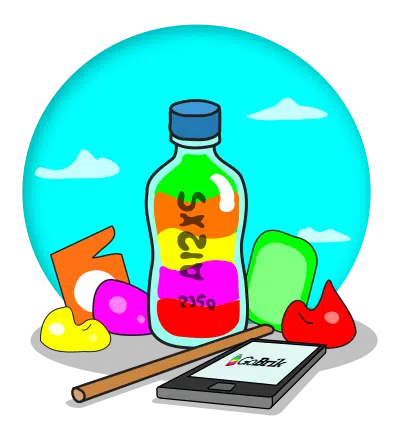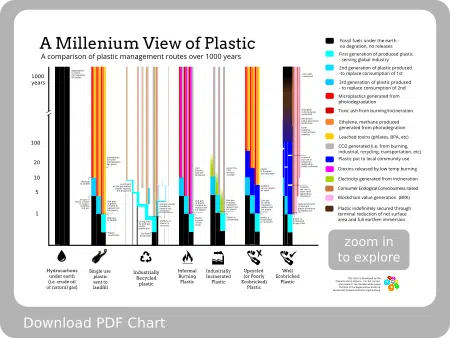Guided by Earth's example, ecobricking doesn't just prevent pollution. As a hands on experience of Earthen and regenerative principles, ecobricking embodies our transition from petro-capitalism to a green new world.
The South East Asian ecobrick movement emerged out of the ancestral lands of the Igorot people in the Northern Philippines. Our ecobricking remains inspired by their concept of ayyew— an ecological ethos that emulates the very principles by which Earth greened our planet's surface.
Following Earth's Example
We strive to emulate the ways Earth cared for its carbon to green the biosphere.
For the last billion years, Earth has been slow and steady greened our common home.
The way that Earth has cycled and stored carbon has led to the blossoming of the biosphere while providing us an example to follow to do the same. By following the our planet's principles, we can make sure our methods and means are green. Our plastic -- which is made using ancient compacted carbon -- is the perfect place to start!
Following Earth's example is the basis of Earthen ethics: five principles based on our planet's cosmological character.
Spiral: In the same way that Earth tends its carbon towards cycles of indefinite reuse, so too can we with our plastic. By packing our plastic into ecobricks and using our ecobricks properly, we can make sure our plastic can be used over and over in such a way that it steadily enriches local and global ecosystems.
For-Earth: In the same way that Earth’s cycles disperse energy outwards from process, to ecosystem to biosphere, so to can we. In particular: with the process of managing our plastic. Rather than manage our plastic for profit, we can be sure to ecobrick first and foremost for the benefit of the biosphere.
Towards Concentration: In the same way that Earth steadily compacts and secures loose carbon into long-term, concentrated storage so too can we with our plastic. By compacting and concentrating our plastic into a bottle we can make make sure our plastic's carbon doesn't get loose through dumping, burning or industrially recycling.
Towards Diversity: In the same way that Earth’s cycles of carbon lead to more and more biodiversification, so too can we ensure that our cycles of ecobricked plastic do the same. Rather than put our plastic to use just for humans, we can build green spaces that provide a common home for us, animals and plants!
Towards Awareness: In the same way that Earth cultivated higher levels of consciousness, so too can we manage our plastic! Rather than just throwing it away, we can count how much we use each month, how much we ecobrick and track our transition from plastic and the petro-capital system that it represents.
ℹ️ Learn about: The Long Story of Plastic
ℹ️ Source: Earthen Ethics
Leading by Example
Be the change you want to see in the world.
We strive to lead by example with our plastic transition and regenerative living.
Ghandi challenged us all to “be the change you want to see in the world“. Simple and powerful, this is a fundamental principle of the ecobrick and Earthen movement. As plastic consumption is something that connects us across continents and cultures, what we do with our plastic, our own stories of transition, provide a shining beacon for others to follow.

By leading by example in following Earth's example, we can be a powerful inspiration.

Especially, when our example is amplified by our plastic accounting. After all, how can we be sure our examples are actually worthy of being followed? For this reason, we strive to track the plastic we consume, produce, ecobrick, and offset to make sure our net impact is in fact green.
🟢 Our catalyst program allows organizations, projects, and enterprises to lead by example with their plastic accounting.
🟢 Tracking one's personal or household plastic transition score is a way to lead by example.
Local & Replicable
Low-tech, carbon-negative, open & replicable methodologies
We strive towards methods and means that are accessible to anyone, anywhere.
Every day thousands of tons of plastic flow into the biosphere. Meanwhile, the consumption of plastic and its production ever increases. In order to be a deep solution to plastic, a regenerative solution must spread at a rate faster than industrial expansion rates. In order to maximize spread, adoption, and collective plastic transition we strive to maximize the accessibility of our methods while minimizing the barriers to adoption. In this way, we empower others to make and build with ecobricks so that they can lead by their own example.

Our principle of local replicability encompasses several of our other principles.

- Localized: By designing with local, organic or upcycled materials (that are ideally freely available) we remove resource barriers to replication.
- Petro-Capital Transition: By designing methods that do not require machines, we remove the barrier of technology, specific skills, and dependence on petroleum-based energy.
- Transcaste: By designing our methods so that they do not require specialized abilities we remove age, gender, and geographical barriers to replication and empowerment.
- Open Source: By making our designs open source according to creative commons specifications and easily accessible on the web, we energize and accelerate replication.
- Non-Capital: By designing methods and using materials that do not require capital, we remove the financial barrier to participation and replication.
- Local: We strive to employ locally available resources in our ecobrick applications. First and foremost, ecobricking is all about packing our local plastic. This begins with the very plastic we have personally consumed, then extends to that consumed in our household and community. Ideally, we use PET bottles that come from our community and a stick that comes from our area. This way we transform plastic that would otherwise cause problems in our area with the minimum amount of energy and the maximum amount of social empowerment.
- Spirally Designed: Ecobricks and all their applications are designed for indefinite cycles that are enriching ecologically and socially.
When it comes to building with ecobricks, the same principle of localized sourcing applies. We strive to use local materials, processes, skills, and culture for our creations. For example, we have developed the ecobrick tube banding method of bonding ecobricks to make use of the abundance of free and ‘waste’ motorcycle inner-tubes in South East Asia. In the UK we learn from ancient earth building traditions of wattle and daub to combine ecobricks using local clay, straw, and sand.
By using materials, goods, services, and products that come from within our community and region we likewise minimize our dependence on capital and petroleum.
Mandalic Collaboration
Our intentions are powered by mandalic community collaboration.
Leading by example leverages the full power of mandalic collaboration. Sharing our example allows others to be inspired by our story, insights, practices and net impact. In so doing we consciously place ourselves in the center of a replicating, social unfolding.
There are different words for it in cultures around the world– the Igorots call it Obo’obo, in Africa its know as ubuntu, in Indonesia gotongrayong, in the Philippines Kawasan. Whatever the term, the dynamic is the same: a community coming together to realize a shared vision and intention.

Most often, this is an intention that is for the whole community’s benefit– such as building a bridge or a well.

In our case, it is our common intention of keeping plastic out of the biosphere. By holding a mission that is to the benefit of individuals, people, communities and the planet, the GEA enables this formidable force to power the realization of its vision.
This principle is in contrast to the means by which capital economy motivates and inspires participation through financial remuneration. As a non-capital technology, ecobricking taps a deeper, more potent values such as community cleanliness, the health of children, the richness of the local ecology, to inspire participation, action and long term vision commitment.
For example, these very words are translated into other languages– not because we have paid anyone– but because they are in full resonance with the ecological passion of others who, resonating with our mission and vision, have offered their linguistic and programming expertise to make this happen.
Learn about the way of mandalic collaboration.
Transcaste
Open to all
We strive to include men and women, young and old, atheists and theists, rich and poor… and everyone in between!
In our methods, projects and intentions we strive to rise above old notions of roles and ability and accessibility. We encourage the collaboration of groups that are often perceived to have different social rankings (i.e., ‘castes’) to work together on an equal platform of participation. In other words, rather than a child doing one task and an adult doing another, we design the method so that both can do it together.
For example, the work of making an ecobrick, making a module or building with earth are designed to be equally accessible to just about everybody– and in such a way that no one has an advantage by virtue of skill, strength, or experience. In this way, men and women, boys and girls can be equally involved in the co-creative process without traditional castes causing alienation.

This enables us to rise above old gender and generational divides to supercharge our collaborations with many variations of human creativity while further lowering the barriers of replication.

Sustainability vs Regenerative
It can be helpful to better understand what we mean by regenerative by clarifying what it is now. Ecobricking is often mistaken as ‘sustainable’ technology. ‘Sustainability’ tends to refer to the virtue of enabling our current human systems and current way of life to continue. Here, guided by the Earthen principles above, ecobricking technology is not this. Instead, as regenerative technology, we strive to transition from sustaining the current human systems that deplete ecosystems to ways of living that enrich.
In this way, our principles are not anti-industry, nor anti-petro-capital. Without them, we would not have come to the principles we now hold. We acknowledge that yesterday’s use of Earth gifted carbon has been an important formative phase that sets us on our current course-correction.
With this, we move on from 'sustaining'. Insofar as our modern enterprises work in ways that conflict with Earth’s example of carbon care, we strive to transition from them. We also strive to heal and ‘regenerate’ any past damage that we are responsible for. Finally, in contrast to the sustainability’s focus on minimizing grey impacts, instead we strive in the ayyew spirit of syncing with Earth’s cycles to ever increase our green impacts.
Learn about the indigenous wisdom tradition that underlies the regenerative ecobrick movement.
Ecological Accounting
Accounting for our grey and green ecological impacts is a key component of regenerative enterprise.
See Ours
See how we account
For-Earth Enterprise
The GEA commits to a not-for-profit business model that disperses any financial surpluses to ecological benefits. We do this by disclosing our carbon, plastic and biodiversity impacts and by ensuring that they are net-green.
Our Example
See how we do it.
Vitalizing Biodiversity
Just as Earth has vitalized processes that diversify, so too can we.
Towards Concentration
Ecobrick applications follow Earthen design principles to integrate plastic in spiral cycles that spiral towards sequestration.
Learn more
The principle of concentration
Spiral Design
Ecobrick applications follow the Earthen principle of crafting enriching cycles-- both socially and ecologically.
Learn More





